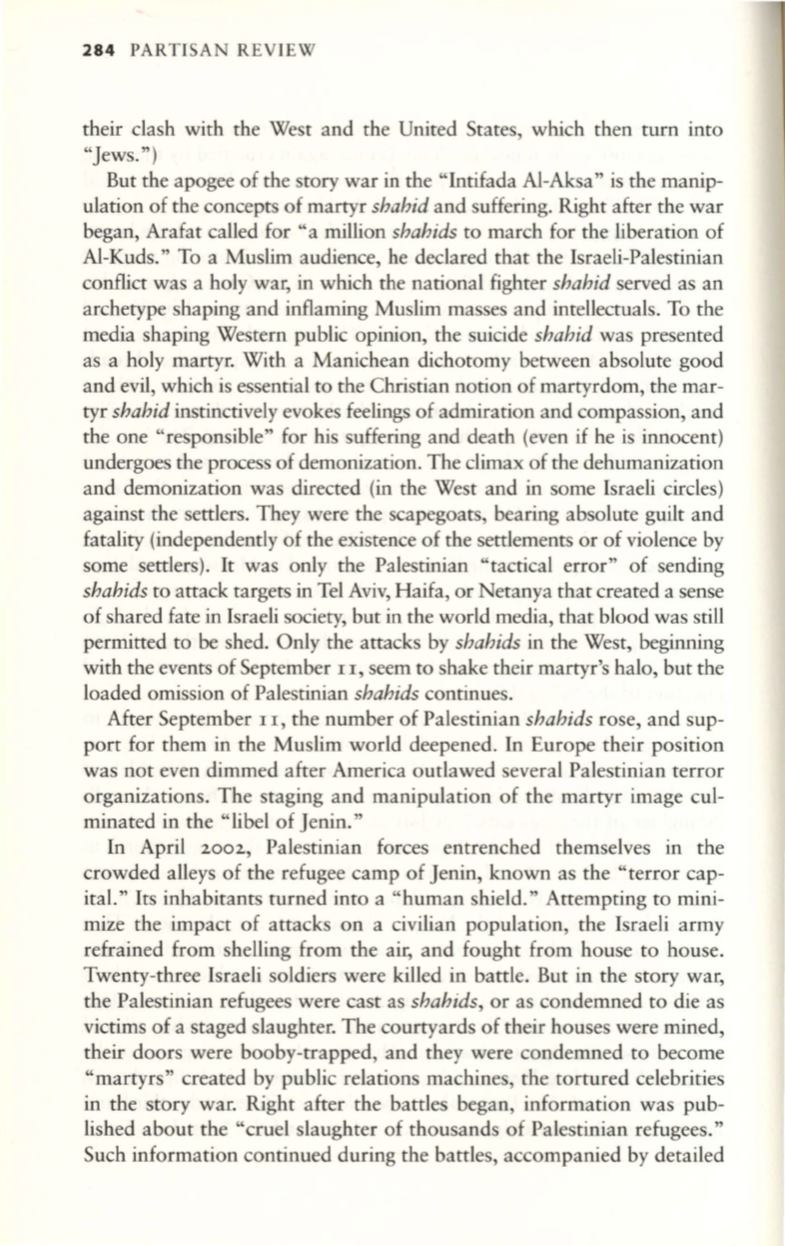
284
PARTISAN REVIEW
their clash with the West and the United States, which then turn into
"Jews."}
But the apogee of the story war
in
the "Intifada AI-Aksa" is the manip–
ulation of the concepts of martyr
shahid
and suffering. Right after the war
began, Arafat called for "a million
shahids
to march for the liberation of
Al-Kuds." To a Muslim audience, he declared that the Israeli-Palestinian
conflict was a holy war, in which the national fighter
shahid
served as an
archetype shaping and inflaming Muslim masses and intellectuals. To the
media shaping Western public opinion, the suicide
shahid
was presented
as a holy martyr. With a Manichean dichotomy between absolute good
and evil, which is essential to the Christian notion of martyrdom, the mar–
tyr
shahid
instinctively evokes feelings of admiration and compassion, and
the one "responsible" for his suffering and death (even if he is innocent)
undergoes the process of demonization. The climax of the dehumanization
and demonization was directed (in the West and in some Israeli circles)
against the settlers. They were the scapegoats, bearing absolute guilt and
fatality (independently of the existence of the settlements or of violence by
some settlers). It was only the Palestinian "tactical error" of sending
shahids
to attack targets in Tel Aviv, Haifa, or Netanya that created a sense
of shared fate in Israeli society, but in the world media, that blood was still
permitted to be shed. Only the attacks by
shahids
in the West, beginning
with the events of September
I I,
seem to shake their martyr's halo, but the
loaded omission of Palestinian
shahids
continues.
After September
I I,
the number of Palestinian
shahids
rose, and sup–
port for them in the Muslim world deepened.
In
Europe their position
was not even dimmed after America outlawed several Palestinian terror
organizations. The staging and manipulation of the martyr image cul–
minated in the "libel of Jenin."
In
April
2002,
Palestinian forces entrenched themselves in the
crowded alleys of the refugee camp of Jenin, known as the "terror cap–
ital." Its inhabitants turned into a "human shield." Attempting to mini–
mize the impact of attacks on a civilian population, the Israeli army
refrained from shelling from the air, and fought from house to house.
Twenty-three Israeli soldiers were killed in battle. But in the story war,
the Palestinian refugees were cast as
shahids,
or as condemned to die as
victims of a staged slaughter. The courtyards of their houses were mined,
their doors were booby-trapped, and they were condemned to become
"martyrs" created by public relations machines, the tortured celebrities
in the story war. Right after the battles began, information was pub–
lished about the "cruel slaughter of thousands of Palestinian refugees."
Such information continued during the battles, accompanied by detailed


